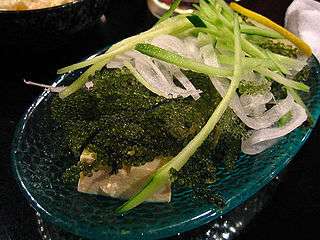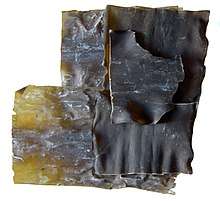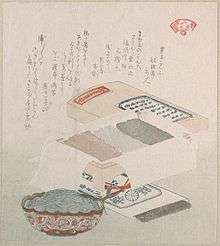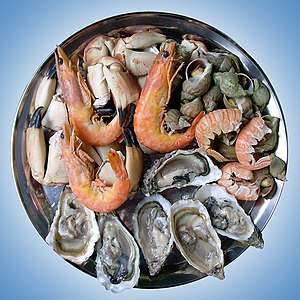Edible seaweed
Edible seaweed, or sea vegetables, are seaweeds that can be eaten and used in the preparation of food. They typically contain high amounts of fiber.[1][2] They may belong to one of several groups of multicellular algae: the red algae, green algae, and brown algae.[1]
.jpg)
Seaweeds are also harvested or cultivated for the extraction of polysaccharides [3] such as alginate, agar and carrageenan, gelatinous substances collectively known as hydrocolloids or phycocolloids. Hydrocolloids have attained commercial significance, especially in food production as food additives.[4] The food industry exploits the gelling, water-retention, emulsifying and other physical properties of these hydrocolloids.[5]
Most edible seaweeds are marine algae whereas most freshwater algae are toxic. Some marine algae contain acids that irritate the digestion canal, while some others can have a laxative and electrolyte-balancing effect.[6] Most marine macroalgae are nontoxic in normal quantities, but members of the genus Lyngbya are potentially lethal.[7] Typically poisoning is caused by eating fish which have fed on Lyngbya or on other fish which have done so.[7] This is called ciguatura poisoning.[7] Handling Lyngbya majuscula can also cause seaweed dermatitis.[8] Some species of Desmarestia are highly acidic, with vacuoles of sulfuric acid that can cause severe gastrointestinal problems.[7]
The dish often served in western Chinese restaurants as 'Crispy Seaweed' is not seaweed but cabbage that has been dried and then fried.[9]
Distribution
Seaweeds are used extensively as food in coastal cuisines around the world. Seaweed has been a part of diets in China, Japan and Korea since prehistoric times.[10] Australia and New Zealand also have eaten it, but only since Asians reached Australia in the 1800s. Seaweed is also consumed in many traditional European societies, in Iceland and western Norway, the Atlantic coast of France, northern and western Ireland, Wales and some coastal parts of South West England,[11] as well as New Brunswick, Nova Scotia, and Newfoundland and Labrador. The Māori people of New Zealand traditionally used a few species of red and green seaweed.[12]
Nutrition and uses
Seaweed contains high levels of iodine relative to other foods.[13] In the Philippines, Tiwi, Albay residents created a new pancit or noodles made from seaweed, which can be cooked into pancit canton, pancit luglug, spaghetti or carbonara and is claimed to have health benefits[14] such as being rich in calcium, magnesium and iodine.[15]
One study in 2014 pointed to certain species of seaweed as being a possible vegan source of biologically-active Vitamin B12. The study noted that B-12 was found in both raw and roasted seaweed, the latter containing about half as much—but still a sufficient amount. A mere 4 grams of dried purple laver is considered sufficient to meet the RDA for B-12.[16]
Polysaccharides in seaweed may be metabolized in humans through the action of bacterial gut enzymes. Such enzymes are frequently produced in Japanese population due to their consumption of seaweeds.[17]
In some parts of Asia, nori 海苔 (in Japan), zicai 紫菜 (in China), and gim 김 (in Korea), sheets of the dried red alga Porphyra are used in soups or to wrap sushi or onigiri. Chondrus crispus (commonly known as Irish moss) is another red alga used in producing various food additives, along with Kappaphycus and various gigartinoid seaweeds.
Japanese cuisine has seven types of seaweed identified by name, and thus the term for seaweed in Japanese is used primarily in scientific applications, and not in reference to food.
 Sea grapes (Caulerpa lentillifera) are cultivated in ponds in the Philippines[18]
Sea grapes (Caulerpa lentillifera) are cultivated in ponds in the Philippines[18] Sea grapes are usually eaten raw with vinegar, as a snack or in a salad[19]
Sea grapes are usually eaten raw with vinegar, as a snack or in a salad[19]
 Dasima (kelp)
Dasima (kelp)
 Cakes and Food Made of Seaweed by Kubo Shunman, 19th century
Cakes and Food Made of Seaweed by Kubo Shunman, 19th century
Seaweed oil
Seaweed oil, also called Algae oil, is used for making food.[20] Seaweed oil is also used as a source of fatty acid dietary supplement, as it contains mono- and polyunsaturated fats, in particular EPA and DHA, both of them Omega-3 fatty acids .[21] Its DHA content is roughly equivalent to that of salmon based fish oil.[22][23]
Seaweed oil is also used for biofuel, massage oil, soaps, and lotions.
Common edible seaweeds
Common edible seaweeds[24] include:
Red algae (Rhodophyta)
Green algae
|
Brown algae (Phaeophyceae)Kelp (Laminariales)
Fucales
Ectocarpales
|
See also
- Aquaculture of giant kelp
- Seaweed farming
- Specialty foods
References
- Garcia-Vaquero, M; Hayes, M (2016). "Red and green macroalgae for fish and animal feed and human functional food development". Food Reviews International. 32: 15–45. doi:10.1080/87559129.2015.1041184.
- K.H. Wong, Peter C.K. Cheung (2000). "Nutritional evaluation of some subtropical red and green seaweeds: Part I — proximate composition, amino acid profiles and some physico-chemical properties". Food Chemistry. 71 (4): 475–482. doi:10.1016/S0308-8146(00)00175-8.
- Garcia-Vaquero, M; Rajauria, G; O'Doherty, J.V; Sweeney, T (2017-09-01). "Polysaccharides from macroalgae: Recent advances, innovative technologies and challenges in extraction and purification". Food Research International. 99 (Pt 3): 1011–1020. doi:10.1016/j.foodres.2016.11.016. hdl:10197/8191. ISSN 0963-9969. PMID 28865611.
- Round F.E. 1962 The Biology of the Algae. Edward Arnold Ltd.
- Garcia-Vaquero, M; Lopez-Alonso, M; Hayes, M (2017-09-01). "Assessment of the functional properties of protein extracted from the brown seaweed Himanthalia elongata (Linnaeus) S. F. Gray". Food Research International. 99 (Pt 3): 971–978. doi:10.1016/j.foodres.2016.06.023. hdl:10197/8228. ISSN 0963-9969. PMID 28865623.
- Wiseman, John SAS Survival Handbook
- Turner, Nancy J.; von Aderkas, Patrick (2009). "3: Poisonous Plants of Wild Areas". The North American Guide to Common Poisonous Plants and Mushrooms. Portland, OR: Timber Press. pp. 115–6. ISBN 9780881929294. OCLC 747112294.
- James, William D.; Berger, Timothy G.; et al. (2006). Andrews' Diseases of the Skin: clinical Dermatology. Saunders Elsevier. ISBN 978-0-7216-2921-6.
- Hom, Ken (2012). "Crisp Seeweed". Good Food Channel. UK TV.CO.UK. Retrieved 16 October 2014.
- "Seaweed as Human Food". Michael Guiry's Seaweed Site. Retrieved 2011-11-11.
- "Spotlight presenters in a lather over laver". BBC. 2005-05-25. Retrieved 2011-11-11.
- "Kai Recipe's used by Kawhia Maori & Early Pioneers". Kawhia.maori.nz. Retrieved 2011-11-11.
- "Micronutrient Information Center: Iodine". Oregon State University: Linus Pauling Institute. 2014-04-23. Retrieved 2011-11-11.
- Cooking With Seaweed And The Health Benefits (Infographic)
- "Albay folk promote seaweed 'pansit'". ABS-CBN Regional Network Group. 2008-04-08. Retrieved 2009-08-04.
- Watanabe, Fumio; Yabuta, Yukinori; Bito, Tomohiro; Teng, Fei (2014-05-05). "Vitamin B12-Containing Plant Food Sources for Vegetarians". Nutrients. 6 (5): 1861–1873. doi:10.3390/nu6051861. ISSN 2072-6643. PMC 4042564. PMID 24803097.
- Hehemann, Jan-Hendrik; Correc, Gaëlle; Barbeyron, Tristan; Helbert, William; Czjzek, Mirjam; Michel, Gurvan (8 April 2010). "Transfer of carbohydrate-active enzymes from marine bacteria to Japanese gut microbiota". Nature. 464 (7290): 908–912. Bibcode:2010Natur.464..908H. doi:10.1038/nature08937. PMID 20376150.
- Dawes, Clinton J. (1998). Marine botany. New York: John Wiley. ISBN 978-0-471-19208-4.
- Lato, the strange sea salad The trade of the Caulerpa lentillifera in Coron, Philippines
- New Culinary Trend: Cooking with Algae Oil
- Scott D. Doughman, Srirama Krupanidhi, Carani B. Sanjeevi (2007). "Omega-3 Fatty Acids for Nutrition and Medicine: Considering Microalgae Oil as a Vegetarian Source of EPA and DHA". Current Diabetes Reviews. 3 (3): 198–203. doi:10.2174/157339907781368968. PMID 18220672.CS1 maint: uses authors parameter (link)
- Arterburn, LM (July 2008). "Algal-Oil Capsules and Cooked Salmon: Nutritionally Equivalent Sources of Docosahexaenoic Acid". Journal of the American Dietetic Association. 108 (7): 1204–1209. doi:10.1016/j.jada.2008.04.020. PMID 18589030. Retrieved 20 January 2017.
- Lenihan-Geels, G; Bishop, K. S.; Ferguson, L. R. (2013). "Alternative Sources of Omega-3 Fats: Can We Find a Sustainable Substitute for Fish?". Nutrients. 5 (4): 1301–1315. doi:10.3390/nu5041301. PMC 3705349. PMID 23598439.
- Harrison, M. (2008). "Edible Seaweeds around the British Isles". Wild Food School. Archived from the original on 2015-07-21. Retrieved 2011-11-11.
External links
| Wikimedia Commons has media related to Edible seaweed. |
- Seaweeds used as human food an FAO report
